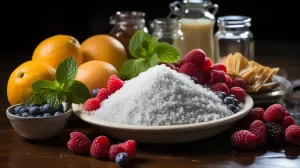A heightened susceptibility to infection is a well-established side effect of using corticosteroid medications. These drugs are often used to manage symptoms of pain, swelling and inflammation in chronic inflammatory diseases such as rheumatoid arthritis, lupus and other rheumatic conditions, as well as vasculitis, psoriasis, and COPDs (chronic obstructive pulmonary diseases)-- including asthma. The most commonly used corticosteroids are fluticasone (Flovent/Flonase) and mometasone (Nasonex), used for allergic and respiratory diseases, hydrocortisone, used in skin and colon inflammation, and Prednisone for managing auto-immune and joint diseases. What kind of nutritional support is helpful for patients under these circumstances, and why?
Corticosteroids and Nutrient Depletion
Corticosteroids are a class of drugs that are synthetic analogues to our own cortisol, only much more powerful. While they effectively dampen inflammation and its symptoms, the unfortunate trade-off they come with is a reduced ability to fight infectious agents. In these times, that can be scary.
To add to that side-effect, they promote nutrient depletion. According to the Natural Medicines Database, corticosteroid drugs such as prednisone deplete calcium, vitamin D, chromium, zinc, potassium and magnesium from the bodies of those who use them. Meanwhile, the drug information resource Clinical Pharmacology also includes the nutrients folic acid, vitamin A and vitamin C on their list. All together, these nutrient depletions may cause or amplify the drugs’ side effects, including water retention, increased blood pressure, reduced bone density and high blood sugar. What’s more is that some of these nutrients are vitally important for immune function, particularly zinc, vitamin C and vitamin D. For these reasons, it would be wise to ensure adequate intake through supplementation.
Here are a few of the most common infections associated with regular corticosteroid use, along with key nutrients that influence incidence and outcomes:
Yeast Infections
An analysis of 16 randomized controlled trials on those with COPD concluded that inhaled corticosteroid therapy nearly tripled the risk of oral thrush, a yeast infection of the mouth (a.k.a. candidiasis). Meanwhile, an Egyptian study found that compared to women who weren’t taking corticosteroid medications, women who used corticosteroids long-term had a significantly higher rate of vulvo-vaginal yeast infections and had them more frequently.
Yeast is a type of fungal organism that normally reside harmoniously inside our digestive tracts in small amounts alongside trillions of bacteria, but it can become a pathogen when given the opportunity to colonize and dominate a region of the body.
While yeast infections for most people are itchy and sore, they’re usually short-lived. However, serious systemic candidiasis is a possibility in the immuno-compromised individual. In fact, this infection kills about 40 to 50 percent of diagnosed patients worldwide.
Natural Support for Candidiasis
Yeasts need sugar to replicate. Whether it’s chronic vaginal yeast infection or oral thrush, it’s important for those susceptible to maintain a diet low in concentrated sugars. This means steering clear of food and beverages made with granulated sugars, syrups and even fruit juices.
The minerals zinc and selenium have been used topically and orally as part of a treatment program for individuals with various fungal infections, including yeast infections. Zinc Glycinate provides glycine-chelated zinc, which is gentle on the digestive system, well-absorbed, and supports the immune system in its pathogen-fighting work. Meanwhile, selenomethionine is a selenium compound that provides methionine-chelated selenium, a mineral necessary for the production of immune-boosting glutathione.
Shingles
Have you had the chickenpox? Herpes varicella-zoster is the same virus responsible for the itchy viral skin outbreak of childhood and can re-activate as a painful outbreak of shingles in adults. According to several large observational studies, individuals using corticosteroids for rheumatoid arthritis management have an increased incidence of shingles. Higher incidence has also been noted in those taking corticosteroids for the management of psoriasis, an auto-immune skin disease.
Does diet matter to shingles? A 2006 case-control study of London residents suggested that a higher intake of vitamins and minerals may be a protective factor against this infection. In particular, when patients’ diets were analyzed, those who ate less than one serving of fruit weekly had over three times the incidence of shingles, compared to those who ate four or more portions daily. For senior citizens of the group, the higher the combined fruit and vegetable intake, the lower the incidence of the disease.
Is it just coincidence that the elderly population have a high rate of vitamin D deficiency, and a harder time overcoming shingles? One retrospective Asian study found that there was a high incidence of vitamin D deficiency in those with “post-herpetic neuralgia”—that is, in those who continued to suffer with pain even after their blisters disappeared. While it remains to be seen if vitamin D impacts pain perception, deficiency is well-linked to reduced viral immunity, adding a reason for all of us to supplement it regularly.
Urinary Tract Infections
In a study that looked back at health records of nearly forty thousand British patients diagnosed with the auto-immune diseases polymyalgia rheumatica (PR) or giant cell arteritis (GCA) over a 20 year span, the higher the dose of corticosteroids used, the higher the incidence of infection. Specifically, lower respiratory tract infections, conjunctivitis (“pink-eye”), herpes zoster and urinary tract infection (UTI) were among the most common infections, with the most common causes of death being pneumonia and kidney infection.
Like most infections, urinary tract infections (UTIs) can be easier to prevent than to cure. That’s when immune-supportive nutrients can be most helpful. Take vitamin C, for example. One 3-month study of pregnant women found that in those taking daily supplementary vitamin C, folic acid and iron, the incidence of UTI was just 12.7 percent; meanwhile, those taking just folic acid and iron experienced an infection rate of 25 percent. The dose of vitamin C used was just 100 milligrams daily. Why does vitamin C help? It’s is an effective acidifier of the urine, a necessity for sterilizing the urinary tract clean of bacteria. To get the most out of your dose, be sure your vitamin C supplement is pure ascorbic acid, sugar-free and made from a non-GMO starch like tapioca.
Pneumonia
It’s concerning that while many individuals suffering from asthma or emphysema use corticosteroids as part of their disease-management program, their vulnerability to infectious lung disease rises with this use. An analysis of 19 randomized controlled trials found a 41% increased risk of pneumonia in those who used inhaled corticosteroids for at least one year. The higher the dose, the higher the risk, with fluticasone being the drug associated with highest incidence of pneumonia occurrence. Remember: breathing is kind of important!
An infection is the last thing an immune-suppressed individual needs. Their risk is amplified because the corticosteroids they take deplete vitamins A, C, D, and folate, plus the minerals calcium, chromium, zinc, potassium and magnesium. Even in those who are not on these drugs, studies show that general infection risk is amplified when levels of these nutrients are low. Fortunately, with careful and purposeful attention to diet and supplementation, the nutrients depleted by these drugs can be easily replaced and their negative impacts mediated accordingly.
References
Boyne R, Arthur JR. The response of selenium-deficient mice to Candida albicans infection. J Nutr. 1986;116(5):816-822.
Chen JY, Lin YT, Wang LK, Hung KC, Lan KM, Ho CH, Chang CY. Hypovitaminosis D in Postherpetic Neuralgia-High Prevalence and Inverse Association with Pain: A Retrospective Study. Nutrients. 2019 Nov 15;11(11):2787.
Cleveland Clinic. Corticosteroids. Accessed online January 3, 2023.
Dr. Megan: Prednisone Pharmacist. “9+ Nutrients Depleted by Prednisone.” Accessed online January 6, 2023.
Farhan MA, Moharram AM, Salah T, Shaaban OM. Types of yeasts that cause vulvovaginal candidiasis in chronic users of corticosteroids. Med Mycol. 2019;57(6):681-687.
Hull CA, Johnson SM. A double-blind comparative study of sodium sulfacetamide lotion 10% versus selenium sulfide lotion 2.5% in the treatment of pityriasis (tinea) versicolor. Cutis. 2004;73(6):425-429.
Kheradmand E, Rafii F, Yazdi MH, Sepahi AA, Shahverdi AR, Oveisi MR. The antimicrobial effects of selenium nanoparticle-enriched probiotics and their fermented broth against Candida albicans. Daru. 2014 Jun 6;22(1):48. doi: 10.1186/2008-2231-22-48.
Kieliszek M, B?a?ejak S, Bzducha-Wróbel A, Kot AM. Effect of selenium on growth and antioxidative system of yeast cells. Mol Biol Rep. 2019;46(2):1797-1808.
Mailoo VJ, Rampes S. Lysine for Herpes Simplex Prophylaxis: A Review of the Evidence. Integr Med (Encinitas). 2017 Jun;16(3):42-46.
Miravitlles M, Auladell-Rispau A, Monteagudo M, et al. Systematic review on long-term adverse effects of inhaled corticosteroids in the treatment of COPD. Eur Respir Rev. 2021;30(160):210075. Published 2021 Jun 23.
Mospan, Cortney M. “Drug-Induced Nutrient Depletions: What Pharmacists Need to Know.” US Pharm. 2019:44 (12): 18-24.
Ochoa-Brust GJ, Fernández AR, Villanueva-Ruiz GJ, Velasco R, Trujillo-Hernández B, Vásquez C. Daily intake of 100 mg ascorbic acid as urinary tract infection prophylactic agent during pregnancy. Acta Obstet Gynecol Scand. 2007;86(7):783-787.
Shakibaie M, Salari Mohazab N, Ayatollahi Mousavi SA. Antifungal Activity of Selenium Nanoparticles Synthesized by Bacillus species Msh-1 Against Aspergillus fumigatus and Candida albicans. Jundishapur J Microbiol. 2015 Sep 8;8(9):e26381.
Thomas SL, Wheeler JG, Hall AJ. Micronutrient intake and the risk of herpes zoster: a case-control study. Int J Epidemiol. 2006;35(2):307-314.
Wolfe F, Caplan L, Michaud K. Treatment for rheumatoid arthritis and the risk of hospitalization for pneumonia: associations with prednisone, disease-modifying antirheumatic drugs, and anti-tumor necrosis factor therapy. Arthritis Rheum. 2006;54(2):628-634.
Wu J, Keeley A, Mallen C, Morgan AW, Pujades-Rodriguez M. Incidence of infections associated with oral glucocorticoid dose in people diagnosed with polymyalgia rheumatica or giant cell arteritis: a cohort study in England. CMAJ. 2019;191(25):E680-E688.
Xie J, Zhu L, Zhu T, Jian Y, Ding Y, Zhou M, Feng X. Zinc supplementation reduces Candida infections in pediatric intensive care unit: a randomized placebo-controlled clinical trial. J Clin Biochem Nutr. 2019 Mar;64(2):170-173.
Youssef J, Novosad SA, Winthrop KL. Infection Risk and Safety of Corticosteroid Use. Rheum Dis Clin North Am. 2016 Feb;42(1):157-76, ix-x.




